
The entrepreneurial ecosystem
The concept of an entrepreneurial ecosystem recognises the influence of a variety of inputs and outputs on entrepreneurs. It acknowledges local challenges and opportunities, national priorities and policy and international drivers including the economy and migration. It recognises that the interaction of these factors creates new opportunities for responding in innovative ways to meet needs and create value.
An institution of higher education is uniquely positioned to engage with these disruptors to entrepreneurship, approaching them as opportunities to create new systems and processes that are better aligned with explicit national or community interests. This recognises that what entrepreneurs create extends beyond their direct field of application to impact the wider ecosystem.
Entrepreneurs need to see their contribution within several overlapping spheres:
- the personal sphere of what works for them as an individual and fits with their goals and ambitions
- the community sphere of inputting into a specific area or need, be it local or national and
- the wider sphere beyond the direct community that is impacted by the entrepreneurial activity.
The opening chapter explores the development of entrepreneurship as a journey. This journey is situated within an ecosystem of different constituents: individuals, stakeholders and institutions, and intentional innovation hubs. The journey is non-linear and reflexive, responding to a multiplicity of inputs and priorities.
The following chapter focuses on women entrepreneurs, recognising that women’s journeys are generally more complicated than men’s and involve variables such as working in a potentially hostile and dangerous environment or dealing with obligations involving care for family.
This chapter shifts our attention from surviving to thriving: difficulties are faced and negotiated and the narrative asserts the positive gains of the journey, rather than critiquing otherrole players as obstacles on the way.
This builds a practice of constructive engagement and overcoming, rather than of confrontation and hostility. It provides a model for collaborative engagement that is relevant beyond this specific context.


What is entrepreneurship?
Although entrepreneurship has arguably been part of human interactions since precolonial and colonial history, entrepreneurship as a term was coined around 1800 by a French economist, Jean-Baptiste Say, who observed how “the entrepreneur shifts resources out of an area of lower [productivity] and into an area of high productivity and greater yield” (Bosman and Fernhaber 2018).
This initial understanding of entrepreneurship positioned the creation of value as central. Over the years, different elements of entrepreneurship have been emphasised, reflecting current contextual understandings and values. It is useful to examine how definitions of entrepreneurship have altered, and will continue to alter (see Table 1), reflecting shifts in understanding of the context and power relations in which entrepreneurship is practised.
Broadening the definition of entrepreneurship provides the opportunity to identify specific distinctions that have influenced perception of what entrepreneurship involves.
These have shifted over time, geographical context and through the gaze of the scholar, to emphasise different aspects that correlate with local and global priorities.
The question to ask is not: “Are you an entrepreneur?” or even, “How entrepreneurial are you?” But rather, “How are you an entrepreneur?” This identifies characteristics of the actor that aligns with entrepreneurship.
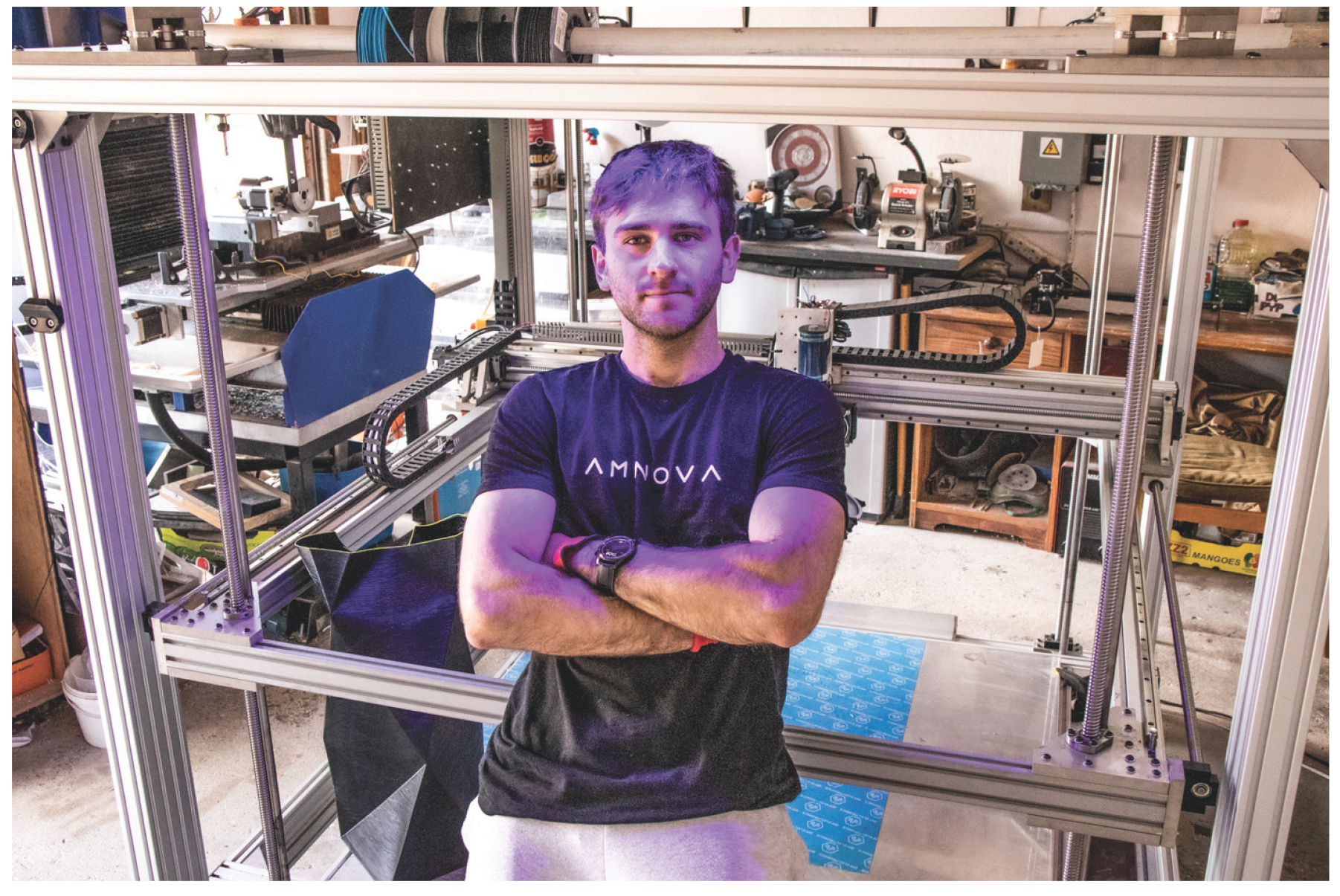

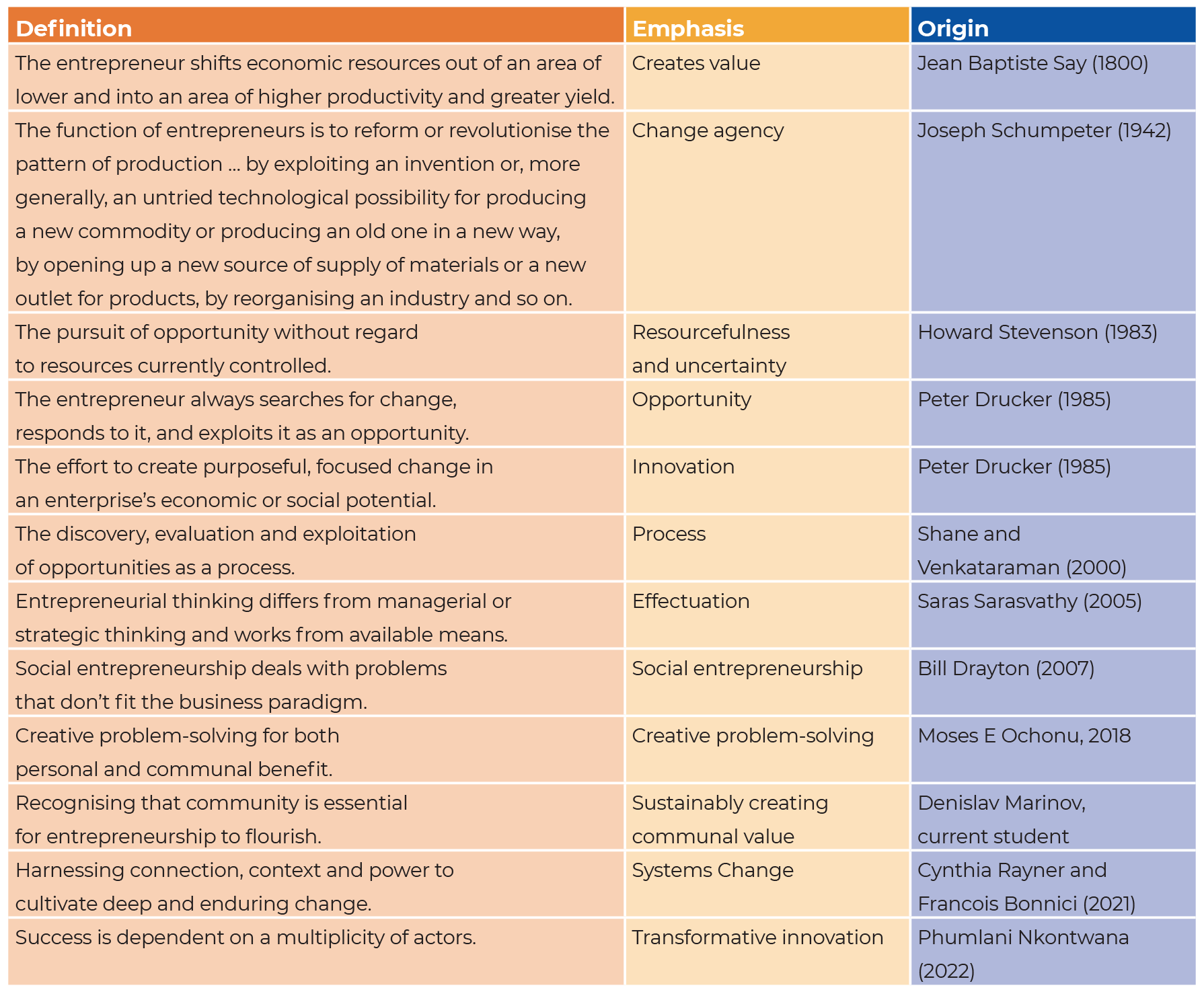


Entrepreneur Journeys:
A reflexive, non-linear hub approach to developing the next generation of innovators
Entrepreneurship is a way of thinking, being, and doing that demonstrates the attitudes, motivation and practice of problem-solving and value creation. Successfully developing entrepreneurs at university is a process that requires a phased educational and training approach – it is a non-linear process, which must draw on varied strategies, because entrepreneurial journeys are complex and diverse. Support needs to work across scales of micro, meso and regime levels of influence in a reflexive way that enables dynamic monitoring and evaluation learning loops.
Entrepreneurship as a way of thinking, being and doing
Entrepreneurship coalesces aspirations and abilities that lead to problem-solving, value creation and grit. A typical entrepreneur must possess a triad of three transversal competencies, namely thinking, being and doing (see Figure 1), which are mutually supportive.
An entrepreneurial mindset incorporates the aspirations and deliberate intentions to plan and pursue a future career as an entrepreneur (Shapero & Sokol, 1982). It is an attitude that seeks to solve problems and add value to society (Bacigalupo, Kampylis, Punie & Van den Brande, 2016). It is linked with specific ways of being and doing that supports the attitudes, motivation and practice of problem-solving and value creation.
Successfully developing entrepreneurs at university, or anywhere, requires a phased educational and development approach (see Table 2). This is a long-term process that takes more than a single person, private organisation or government agency, and requires many players working together intentionally. Danes (2013) calls this a village approach, where proponents of entrepreneurship inspire multitudes of players with a vision of how to transform and improve the social and business environment of a region to become innovation-led and productive.
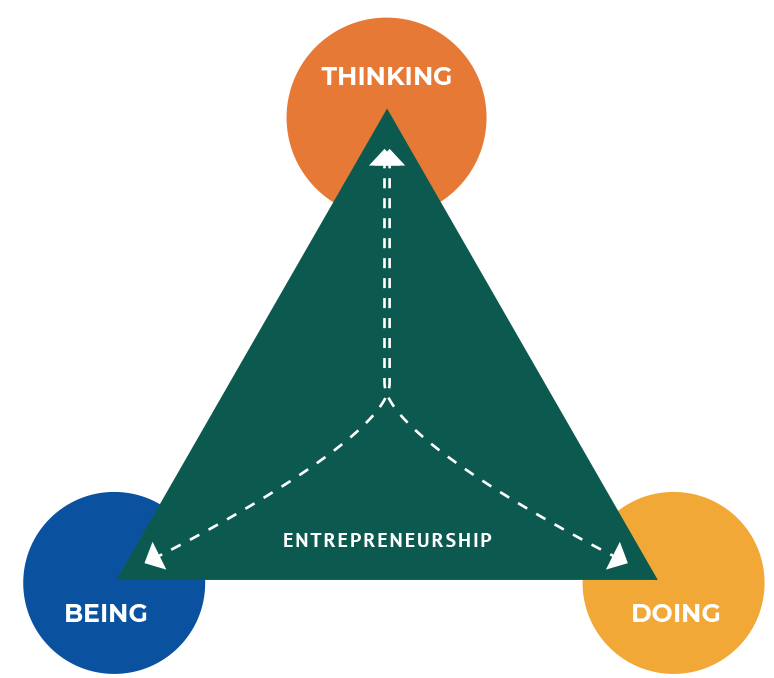
“The hub approach to developing entrepreneurs, positions hubs as centres and spaces – physical or virtual – that provide coworking facilities, as well as financial and non-financial support, to promote technological innovations and entrepreneurship (Jiménez & Zheng, 2017).”

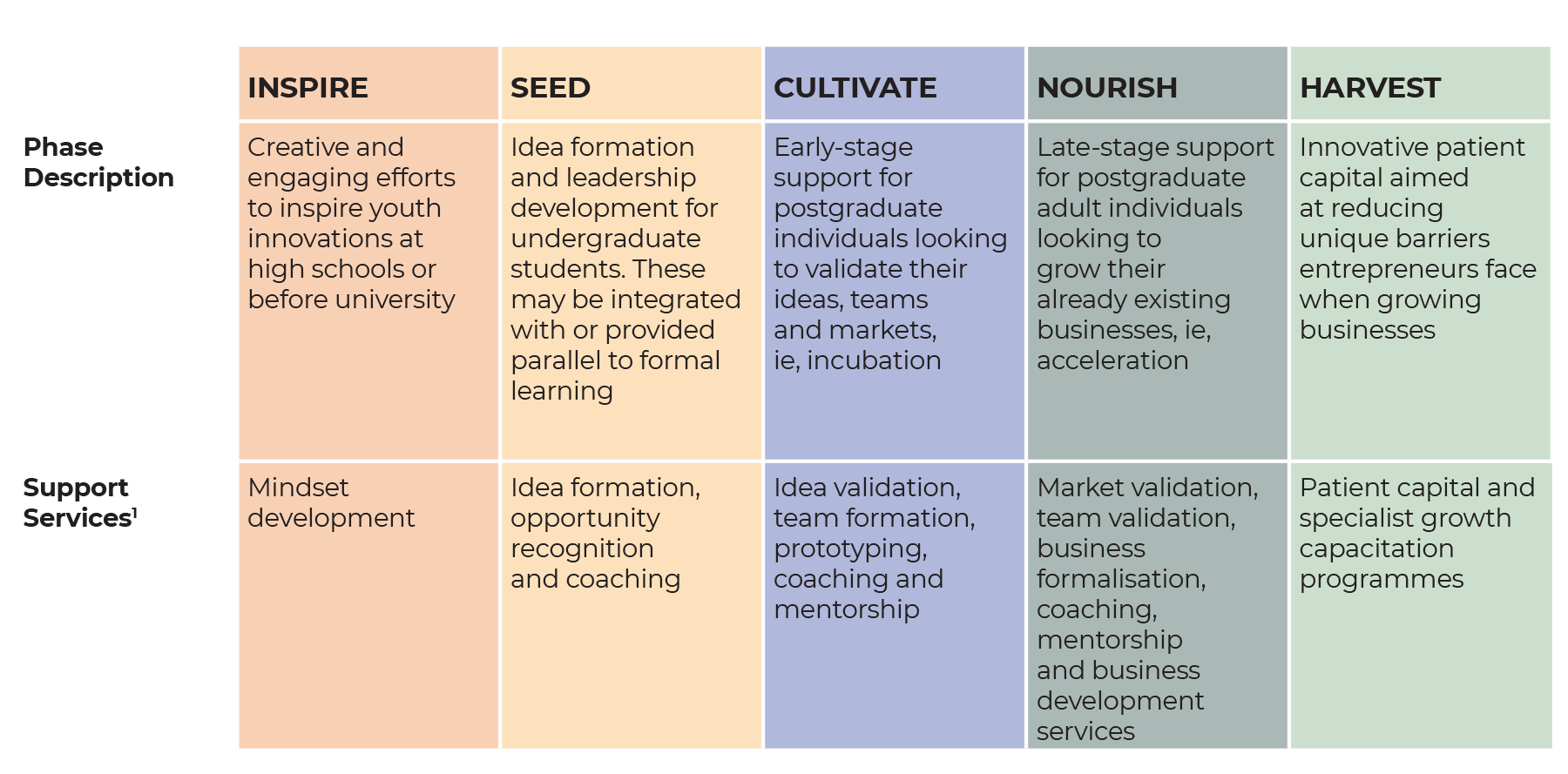
To produce entrepreneurs in the future, innovation stakeholders must start to work with young people today. This process crucially distinguished the idea phase from the start-up phase and the longer-term operational phase. Each phase requires different role players and particular goals.
Table 2 identifies the different stages of the entrepreneurship development process in terms of growth and nurturing. It distinguishes between the distinct processes of coaching, mentorship and business development services.
While investing in the pipeline for the future is important, there are often already aspiring and practicing industry players, who have established themselves outside the university, looking to either start or grow new businesses. This is a distinct group that requires support to make themselves investable as the talent behind the new idea, offering related support such as identifying a suitable co-founder or team so as to embark on the venture together (Lähde, Gorman & Davies, 2018). While finding a co-founder or a team to support a new business idea may sound simple, it can b a daunting task, requiring the idea-owner to be deliberate about bringing in new team members and letting them go at the right time, and being open to new input. Team formation may require stakeholders outside the team of co-founders to facilitate connections, or to design events that enable individuals to meet and interact regularly.
If inspirational and seeding efforts are successful, then newly formed co-founding teams (ie, startup teams) initiating a venture need to cultivate their new ideas by making them unique and attractive to both potential customers and to early-stage finance organisations looking to risk their money on promising ideas, yet to be validated to potential customers or markets (Proparco, 2018; Wangari & Crawford, 2019). This early-stage support is known to be one of the key barriers to new venture creation.
A recent study by Viarnaud, Boisnier, Worms & Nyati (2020) on start-ups in Africa explores this in more detail. Figure 2 shows that entrepreneurs experience funding to be the major challenge in proving a concept, although the impact of funding can be moderated by strategic application of the other elements.
However, new venture creation is more than a successful idea; for it to pay social dividends as well, there must be a deliberate effort to translate early-stage success into high-performing teams and innovative products and services that promise good returns to investors (Chirchietti, 2018).
This phase in the process of entrepreneurship development is called acceleration (InfoDev, 2014) and requires a combination of coaching, mentorship and business development. It is important to note that this phased-process approach is non-linear. Developing entrepreneurs tends to be iterative, imperfect, and involves many failures along the way; it requires multiple learning loops at each phase (Tosey, Visser & Saunders, 2012) and dynamic capacitation approaches tailored for each budding entrepreneur and co-founder team (Zahra, Sapienza & Davidsson, 2006).
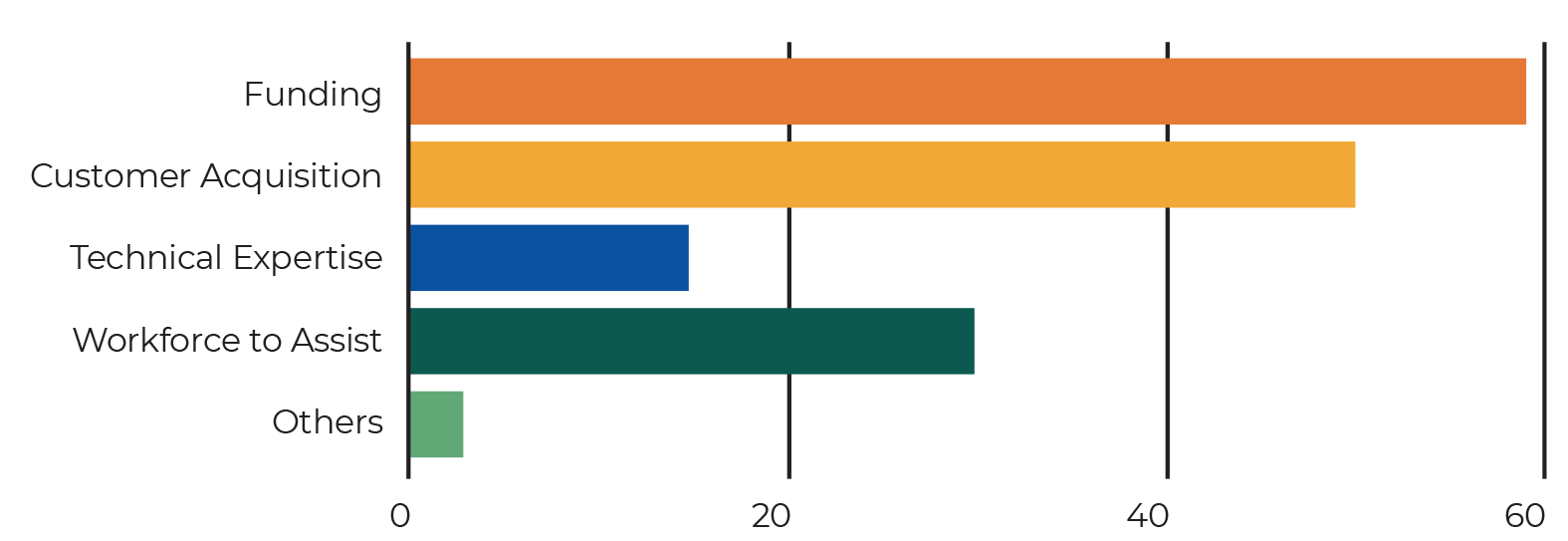
This process is varied and non-linear, because it is rooted in diverse entrepreneur journeys
Successful entrepreneurship requires students to take varied and non-linear journeys. This is usefully illustrated by a capability framework (Dejaeghere & Baxter, 2014) that provides a guide for capacitating youth entrepreneurs, recognising the complexity of the entrepreneurial journey and suggesting a phased and non-linear approach.
The hub approach to developing entrepreneurs, positions hubs as centres and spaces – physical or virtual – that provide co-working facilities, as well as financial and non-financial support, to promote technological innovations and entrepreneurship (Jiménez & Zheng, 2017). Universities can act as hubs, attracting and assembling vital resources needed to start new ventures and grow small businesses such as talent, ideas and capital.
A university can be a vehicle for innovation, accelerating entrepreneurship. Spaces like UCT can facilitate access to skills, finance, markets and related services by collaborating with private equity, venture capital, government agencies, other universities and international development organisations (Friederici, 2017:7). Such hubs are not only supporters and human capital levers but also coordinators for interdependent actors (viz. finance, policy, etc.) that can launch, scale and strengthen entrepreneurship in a particular region (see Figure 3). They play dual roles of supporting local entrepreneurs who participate in their programmes (the intra-function) and a context-relevant orchestration role with other enterprise-support organisations (the interfunction) in order to influence environmental factors that can enable or constrain success.
The UCT student stories and journeys in this book are situated in both the educational context and the broader ecology of support needed from youth, home and other interdisciplinary stakeholders beyond the university hub. Creating entrepreneurs takes an intentional village, and UCT is but one of many village players. In fact, UCT is arguably a microcosm of the bigger Cape Town innovation ecosystem, which creatively uses its institutional equity to leverage financial and non-financial support for students. Universities, as drivers of new knowledge and skills, demonstrate responsive and agile systems that respond to both contextual and epistemological imperatives.


Women entrepreneurs:
Sisters are doing it for themselves

When we think of entrepreneurs, we often imagine businessmen in formal suits – a bias backed up by both entrepreneurship literature and popular media culture. Women get left out of the picture, even though they play an equal, if not more pivotal, role in enacting social transformation through entrepreneurship. With at least seventy percent of the world’s population living on less than a dollar a day, women’s entrepreneurial activities potentially impact the circumstances of whole communities (Chant & Pedwell, 2008, IFC, 2018). Research from the Global Entrepreneurship Monitor in their 2020/21 Women’s Entrepreneurship Report tells us that 17 percent of women in low- and middleincome countries are entrepreneurs, and another 35 percent hope to be. Half of the women in developing countries view entrepreneurship as a viable path for bettering their lives (Elam et. al, 2021).
The field of entrepreneurship has made significant strides toward understanding women as entrepreneurs over the last decade (Jennings & Brush, 2013), yet much remains to be understood, particularly regarding women entrepreneurs in developing contexts. In South Africa, poverty and inequality is most visible among black womenheaded households in township communities. Despite numerous tribulations, township women choose to become entrepreneurs, yet very little research explicates the narratives of these women participating in the informal economy (Grant, 2013).
Having spent the past three years with the same set of township entrepreneurs for my doctoral research, I am able to share the life stories of two inspirational women entrepreneurs. While they struggled with the challenges associated with township life, they have achieved incredible results and have great aspirations. In both cases, distress and disappointment from strained marital relations served as motivation to pursue new ventures and new identities.

Mountaineering Masseuse
Although Zana* married her high school sweetheart, her husband’s expectations about her role as his wife were different from her own. While he wanted her to be a stay-at-home mother to their three children, she wanted to earn her own income and learn new skills. After nine years, their marriage broke down through a betrayal, and she lost all trust in him. Despite it being painful, this experience was something she could use as a catalyst for a new story – a chance to reinvent her life according to her own expectations.
Post-divorce, Zana began to work as a live-in domestic worker in an affluent suburb, where she also began jogging to lose the weight that she had gained during her last pregnancy. This progressed into marathon running and a growing collection of medals. With the advice of her community and friends, she met a man who was working on a project to empower disadvantaged women through mountain climbing. Through this programme, she became one of three township women to receive sponsorship to climb the world’s seven highest mountain peaks. Over the course of two years, she powered her way up Mount Kilimanjaro, Tanzania, Mount El Brus in Russia, Mount Aconcagua in Argentina, and Mount Kosciuszko in Australia.
Even though her quest has stalled after the four mountains, Zana continues to hike up and down Table Mountain in anticipation of one day conquering Mount McKinley in Alaska, Mount Vinson in Antarctica and Mount Everest in Asia.
The project attracted media attention and a documentary about the three ladies aired on national television, leading to more opportunities. Zana became somewhat of a celebrity and was invited to speak at Women’s Day events across the country. She was even offered employment at a well-known outdoor equipment retailer, advising other mountain climbers on hiking and climbing gear. But she eventually grew tired of this role, stating, “I’m not a salesperson. I’m a climber.”
At one of her speaking events, Zana was gifted a massage voucher. The masseuse she went to suggested that she consider doing a massage course, since she challenged her body to such extremes. The seed was planted. Zana went back to her domestic cleaning work and enrolled in a part-time course in massage therapy. Her employers encouraged her and even hosted their friends at a massage party to help her complete the practical components of her course. Her relationship-building ensured that her newfound career could blossom.
Zana then met a renowned massage school teacher, who showed her the art of soy-candle making, among other massage therapy techniques. And, yet again, through her network of teachers and very happy clients, Zana met the owners of a newly constructed business location in the touristic hub of Hout Bay, in Cape Town.
“In the entrepreneurship literature, constructs are often described and studied in dichotomies – in either-or states…I argue that this is too simplistic a lens. Women’s experiences in entrepreneurship exist on a continuum – not in either/or categories.”

When the owners first took Zana to see the planned location, it was nothing more than a dirty, dilapidated building – nearly impossible to imagine as a serene space for her massage therapy venture. But the building progressed, and, with the promise of rental waivers for the first two months, Zana opened her massage therapy stall in July 2011.
Now, more than a decade later, Zana’s venture has not only survived but thrived as she continuously seeks ways to enhance her product range and services. She has worked with a researcher to create a traditional, herb-inspired soy candle made with indigenous imphepho oil. Zana’s clients extend across the globe – from Kuwait to Germany and the United States – and include local politicians who book her prior to arriving in Cape Town. Zana’s children have grown up with her venture, often helping make soy candles, which she does from her house in Imizamo Yethu.
Regardless of what is happening in her personal life, Zana’s business and children are her top priorities. She reflects that if not for her divorce she would have never experienced such a rich, full, and stimulating life. Zana treated her challenges as events to overcome, not as moments over which to languish. It’s thanks to this approach, she says, that she
Growing Green Fingers
Renata* grew up in an insecure household. Not only did her father mistreat her mother, but the fathers of her first two children concealed marriages, and it was a constant struggle to obtain child support. She battled with unemployment for several years. It was her husband’s infidelity (and sudden exit from their lives) that sparked a dramatic change in her life. It came as a shock to Renata – both emotionally and economically destabilising her. How would she care for her four children as a single parent?
Since childhood, Renata loved nurseries and growing plants, and as an adult she nurtured a vegetable garden. This little patch of garden in her backyard saved her family from starving during their most difficult times. But it wasn’t just the food that was life-saving, it was also the action and industry of the work itself which helped her unburden herself psychologically.
Renata’s family saw how important gardening was to her and encouraged her to enter a competition for innovative business ideas run by the city. She thought of her situation, and the thousands of other families without a source of income to feed their families: if they could grow their own food using portable wooden planter boxes, even families without space could have nutritious food to eat. Her idea won her third place and some prize money, which she used to formally register her business.
Renata admits she knew nothing about business when she started. However, she has adopted a growth mindset over the last four years, incubating her venture through several business accelerator and incubator programmes. Through these programmes, she has been able to expand her venture, partner with corporate organisations and supply seedlings to farmers in the region. She has also built several support networks through her association with business incubators. Providing opportunities to travel internationally, Renata has pitched her business to the mayor of Paris, representing the South African Women Entrepreneur of the Year competition. She spent a week at the headquarters of Samsung in South Korea. Her venture has opened her up to a world of opportunities. While her work has taken her abroad, she remains committed to uplifting the lives of the children in her community, who daily deal with gang violence and its related pressures. Operating on the grounds of a local high school, Renata teaches children about the value of growing food sustainably and about nutrition and community.
However, crime is a serious concern – her nursery has been broken into several times. Money and electronics have been stolen, and even seedlings, which take weeks to re-grow. She feels she must minimise publicity about her venture so as not to draw attention from unwanted gang-related elements that place her children at risk.
Renata hopes to one day have her own farm so she can become a national seedling supplier, and so she can build a safer life for her children. While necessity rather than ambition sparked her venture, her idea was an innovative one that solved a community-wide challenge. Looking beyond her own resource constraints, she considered her community of largely unemployed people in need of food for their families, making her a social entrepreneur and the darling of the various accelerator programmes with which she is associated.
In the entrepreneurship literature, constructs are often described and studied in dichotomies – in either/or states. Based on time spent with township-based women entrepreneurs, I argue that this is too simplistic a lens.
Women’s experiences with entrepreneurship exist on a continuum – not in either/or categories. While there are instances where being a female makes the entrepreneurial journey more challenging – for instance when facing gender discrimination in a male-dominated industry – if we consider women’s life stories and their tribulations prior to venturing, it is evident that becoming an entrepreneur if one is a woman can be both fortuitous and beneficial.
Footnotes
- (-) I distinguish between coaching, mentorship and business development services. Coaching focuses on individual support (i.e., mental health, wellbeing) recognising that there is a human being behind the innovation. Mentorship refers to industry-specific support, ideally from an experienced or successful entrepreneur in the same field. This means support focuses more on the team rather than the individual. Business development services refer to industry-specific technical support services to help meet regulation (eg legal, compliance, etc.), reporting (eg accounting, etc.), marketing (eg branding, advertising, communications, etc.), data ethics (eg data privacy, storage, reporting, etc.) standards, among other specialist business services that may or may not be within the co-founding team’s skillset. Table 2 does not prescribe what practitioners should do but suggests which services are critical at which phase of development. It is therefore unlikely, although possible, that a business coach is also a mentor and technical expert in a particular industry.
* Pseudonyms have been used to maintain participants’ anonymity as per UCT ethics in research protocols.
References
- Bosman, Lisa and Fernhaber, Stephanie. 2018. Teaching the Entrepreneurial mindset to engineers Springer: USA ISBN (e-book) 978 3319614120
- Drayton, Bill. 2006. “Everyone a Changemaker: Social Entrepreneurship’s Ultimate Goal,” Innovations 1:1 (Winter): pp. 80-96.
- Nkontwana, Phumlani, S. 2022. African entrepreneurship: An exploration of innovation hubs as development institutions. Stellenbosch University. [Online], Available: file:///C:/Users/aliso/Documents/EDHE/ nkontwana_african_2022%20(1).pdf
- Ochonu, Moses, E. 2018. Entrepreneurship in Africa: A historical approach. Indiana University Press: Bloomington, Indiana.
- Rayner, Cynthia and Bonnici, Francois. 2021 The Systems Work of Social Change. Oxford University Press: Oxford.
- Bacigalupo, M., Kampylis, P., Punie, Y. & Van den Brande, G. 2016. EntreComp: The Entrepreneurship Competence Framework. Luxembourg.
- Chirchietti, N. 2018. The role of Innovation Hubs taking start-ups from idea to business: The case of Nairobi, Kenya.
- Danes, S.M. 2013. Entrepreneurship Success: “The Lone Ranger” Versus “It Takes a Village” Approach? Entrepreneurship Research Journal. 3(3):277–286.
- Dejaeghere, J. & Baxter, A. 2014. Entrepreneurship education for youth in sub-Saharan Africa: A capabilities approach as an alternative framework to neoliberalism’s individualizing risks. Progress in Development Studies. 14(1):61–76.
- Friederici, N. 2017. Innovation Hubs in Africa: An Entrepreneurial Perspective. United Kingdom: Oxford Internet Institute.
- Jiménez, A. & Zheng, Y. 2017. A Spatial Perspective of Innovation and Development. In M. Sakarovitch, J., Goedicke, M., Tatnall, A., Neuhold, E.J., Pras, A., Tröltzsch, F., Pries-Heje, J., Whitehouse, D., Reis, R., Furnell, S., Furbach, U., Winckler, M., Rauterberg (ed.). Yogyakarta: Springer’s IFIP Advances in Information and Communication Technology (IFIP AICT) International Federation of Information Processing (IFIP) Working Group 9.4. 1–11.
- Lähde, K., Gorman, C. & Davies, E. 2018. CATALYSING AND SCALING INNOVATION IN TANZANIA: A REVIEW OF APPROACHES. Dar es Salaam. [Online], Available: https://www. yumpu.com/en/document/view/63434869/ catalysing-and-scaling-innovation-in-tanzania.
- Nkontwana, P.S. 2022. African entrepreneurship: An exploration of innovation hubs as development institutions. Stellenbosch University. [Online], Available: file:///C:/Users/aliso/Documents/ EDHE/nkontwana_african_2022%20(1).pdf
- Proparco. 2018. FINANCING START-UPS TO BUILD TOMORROW ’ S AFRICAN ECONOMIES. Private Sector & Development. (March):1–52.
- Shapero, A. & Sokol, L. 1982. The Social Dimensions of Entrepreneurship. Encyclopedia of Entrepreneurship. 72–90. [Online], Available: https://ssrn.com/abstract=1497759.
- Tosey, P., Visser, M. & Saunders, M.N.K. 2012. The origins and conceptualizations of “triple-loop” learning: A critical review. Management Learning. 43(3):291–307.
- Viarnaud, C., Boisnier, L., Worms, V. & Nyati, P. 2020. The State of Tech Innovation in Africa: Perspectives from founders, investors and corporates. Cape Town. [Online], Available: https://www.africarena.com/report2020.
- Wangari, B. & Crawford, R. 2019. UNLOCKING PIPELINE: A Playbook for Entrepreneur Support in Africa.
- Zahra, S.A., Sapienza, H.J. & Davidsson, P. 2006. Entrepreneurship and dynamic capabilities: A review, model and research agenda. Journal of Management Studies. 43(4):917–955.
- Chant, S., & Pedwell, C. (2008). Women, gender and the informal economy: An assessment of ILO research and suggested ways forward. Geneva: International Labour Organisation.
- Elam, A., Hughes, K., Guerrero, M., Hill, S., Nawangpalupi, C., del Mar Fuentes M., Gonzalez, et. al. (2021) Women’s Entrepreneurship 2020/21: Thriving Through Crisis. Global Entrepreneurship Research Association.
- Grant, R. (2013). Gendered spaces of informal entrepreneurship in Soweto, South Africa. Urban Geography, 34 (1): 86-108.
- IFC (2018). The Unseen Factor. A report on the MSME opportunity in South Africa. [Report.]. Washington D.C.: International Finance Corporation, World Bank Group.
- Jennings, J.E., & Brush, C.G. (2013). Research on women entrepreneurs: Challenges to (and from) the broader entrepreneurship literature? Academy of Management Annals, 7 (1): 663-715.
What is entrepreneurship?

Entrepreneur Journeys: A reflexive, non-linear hub approach to developing the next generation of innovators
